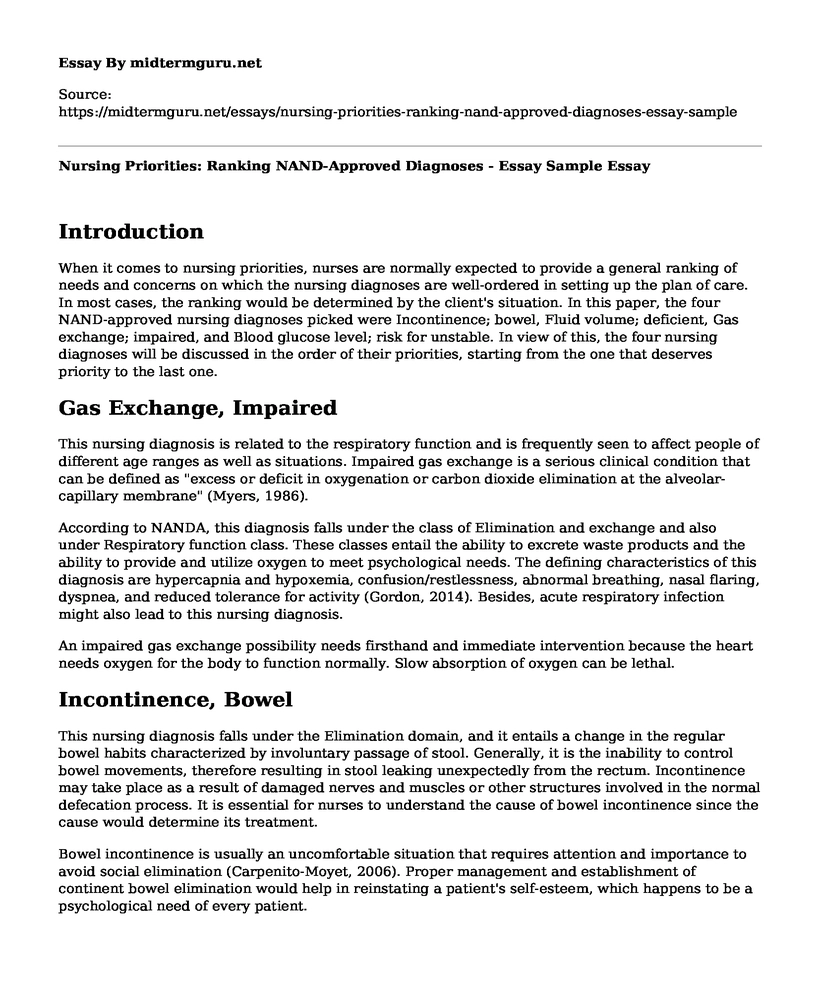Introduction
When it comes to nursing priorities, nurses are normally expected to provide a general ranking of needs and concerns on which the nursing diagnoses are well-ordered in setting up the plan of care. In most cases, the ranking would be determined by the client's situation. In this paper, the four NAND-approved nursing diagnoses picked were Incontinence; bowel, Fluid volume; deficient, Gas exchange; impaired, and Blood glucose level; risk for unstable. In view of this, the four nursing diagnoses will be discussed in the order of their priorities, starting from the one that deserves priority to the last one.
Gas Exchange, Impaired
This nursing diagnosis is related to the respiratory function and is frequently seen to affect people of different age ranges as well as situations. Impaired gas exchange is a serious clinical condition that can be defined as "excess or deficit in oxygenation or carbon dioxide elimination at the alveolar-capillary membrane" (Myers, 1986).
According to NANDA, this diagnosis falls under the class of Elimination and exchange and also under Respiratory function class. These classes entail the ability to excrete waste products and the ability to provide and utilize oxygen to meet psychological needs. The defining characteristics of this diagnosis are hypercapnia and hypoxemia, confusion/restlessness, abnormal breathing, nasal flaring, dyspnea, and reduced tolerance for activity (Gordon, 2014). Besides, acute respiratory infection might also lead to this nursing diagnosis.
An impaired gas exchange possibility needs firsthand and immediate intervention because the heart needs oxygen for the body to function normally. Slow absorption of oxygen can be lethal.
Incontinence, Bowel
This nursing diagnosis falls under the Elimination domain, and it entails a change in the regular bowel habits characterized by involuntary passage of stool. Generally, it is the inability to control bowel movements, therefore resulting in stool leaking unexpectedly from the rectum. Incontinence may take place as a result of damaged nerves and muscles or other structures involved in the normal defecation process. It is essential for nurses to understand the cause of bowel incontinence since the cause would determine its treatment.
Bowel incontinence is usually an uncomfortable situation that requires attention and importance to avoid social elimination (Carpenito-Moyet, 2006). Proper management and establishment of continent bowel elimination would help in reinstating a patient's self-esteem, which happens to be a psychological need of every patient.
Fluid Volume, Deficient
This particular nursing diagnosis falls under the food/fluid domain, which involves the ability to maintain the intake of and utilize nutrients and liquids to meet psychological needs. Deficient fluid volume is a condition where the fluid output exceeds the fluid intake (Carpenito-Moyet, 2006). It occurs when the water, as well as electrolytes, are absent in reasonable quantities. Causes of loss of fluid include polyuria, increased perspiration, and gastrointestinal tract.
This diagnosis requires appropriate management which is important to prevent capable life-threatening hypovolemic shock. Older patients are more likely to experience fluid imbalances, and therefore nurses need to understand that.
Blood Glucose Level, Risk for Unstable
This refers to the risk of variation in blood glucose or sugar levels from the normal range. High sugar levels, known as hyperglycemia, may cause diabetes mellitus.
This nursing diagnostic bears the least priority because the sugar levels can be maintained at any time under proper prescription. Besides, as part of managing blood glucose levels, not forgetting the overall health, patients are encouraged to keep a healthy weight through exercising often and taking healthy diets.
References
Myers, J. L. (1986). Nursing care plans: nursing diagnosis and intervention. M. Gulanick, A. Klopp, D. Gradishar, S. Galanes, & M. K. Puzas (Eds.). Mosby. https://nurseslabs.com/nursing-care-plans/
Carpenito-Moyet, L. J. (Ed.). (2006). Nursing diagnosis: Application to clinical practice. Lippincott Williams & Wilkins.
Gordon, M. (2014). Manual of nursing diagnosis. Jones & Bartlett Publishers. https://www.jblearning.com/catalog/productdetails/9781284044430
Cite this page
Nursing Priorities: Ranking NAND-Approved Diagnoses - Essay Sample. (2023, Feb 05). Retrieved from https://midtermguru.com/essays/nursing-priorities-ranking-nand-approved-diagnoses-essay-sample
If you are the original author of this essay and no longer wish to have it published on the midtermguru.com website, please click below to request its removal:
- Essay Sample on Drug Price Control
- The Last Wishes Letter
- Research Paper on Pregnant Women in Prison
- The Difference Between Income and Occupation of Nurses - Essay Sample
- Case Study on Pathophysiology of David's Lower Back Pain
- Medicare: Federal Health Insurance for Aged, Disabled & ESRD - Essay Sample
- Annotated Bibliography on Moral Distress and Critical Care Nurses







